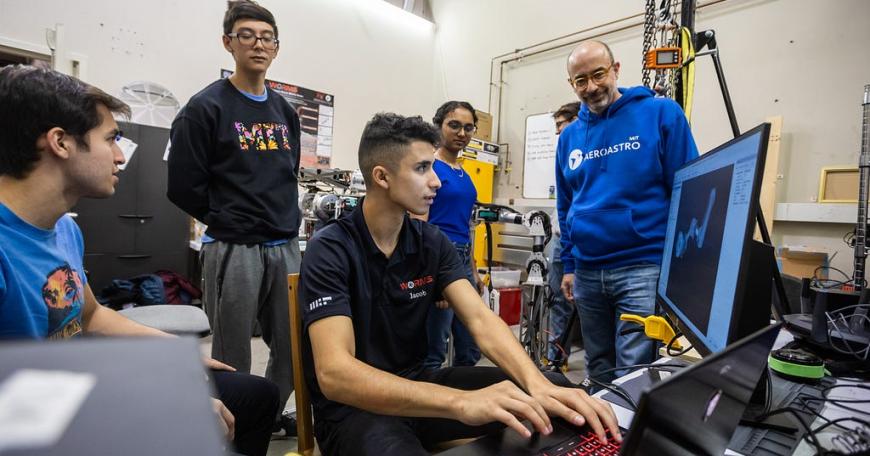
Lessons in building the future of teaching and learning
By Yvonne Ng
The Covid-19 pandemic created radical shifts in approaches to teaching and learning. And while the social, emotional, and mental toll of the pandemic has diminished greatly over the last four years, residual challenges still remain for students and educators. Mary Ellen Wiltrout PhD ’09, director of online and blended learning initiatives, lecturer, and digital learning scientist in Biology at MIT, has identified these shifts in her article, “How to build the future of teaching and learning while growing from the changes and challenges of 2020–21.”
In her article, published in 2022 in Advances in Online Education: A Peer-Reviewed Journal, Wiltrout hypothesized on the lasting impacts of the 2020–2021 events on teaching and learning organized across seven themes: course logistics, tools, activities and assessment for learning, student services and programs, work culture, attitudes, and relationships. Now in 2024 at MIT, Wiltrout can see the positive changes continuing and progressing in these areas:
Flexibility: During the pandemic, instructors were more flexible about coursework requirements, scheduling, grading structure, and expanded the number and types of assignments beyond summative exams. Some enacted policies enabling partial flexibility such as dropping the lowest score on assignments or allowing for late submissions. Now, with student support services approval, instructors remain open to working with students in need of flexibility.
Online learning: Residential colleges relying on completely in-person education now incorporate more blended learning and online courses for students interested in that option. Hybrid instruction and online assignments continue to be part of the curriculum.
Technology: The most valuable functions of the learning management system are the organization of course events and materials and the integration of the multitude of learning tools in one place with one login (for example, web conferencing, discussion forum, grading, video, and calendar). As a result of reducing barriers, more tools like online conferencing, polling, and tablet drawing software to teach, are being used by a larger percentage of teaching staff and students.
Reducing unconscious bias: Grading exams and assignments through an online tool increased the efficiency and consistency of grading with rubrics for every question. And the ability to anonymize submissions in the grading process helps reduce unconscious biases, while students also gain transparency from the rubrics to learn from mistakes and trust the process.
Rethinking in-person sessions: More conversations emerged on how to take advantage of in-person interactions to prioritize activities of value in that mode for learning and work. Instructors and students intentionally kept online approaches that enriched the experience as students returned to campuses. Some digital components enhance student learning, mental well-being, equity, or inclusion and could be as easy as providing a course chat channel for peer-to-peer and peer-to-staff conversations during synchronous sessions. Some instructors maintained more creative, open-ended assignments and online exam policies that seemed experimental during 2020.
Demand for student support services: The effects of the pandemic combined with normalizing taking care of mental health resulted in the sustained high demand for student support services. Institutions continue to invest more in the staffing of these services and programs, such as peer mentoring programs that result in positive academic and attitudinal gains for students. Instructors are generally more aware of how to positively influence students to seek help with simple actions, like speaking in a warm tone and intentionally including a statement about student services.
Belonging and inclusion: Racial and social injustices are being addressed more openly than ever before. Many institutions are recognizing the value and importance of diversity, equity, and inclusion in their students and staff and have invested in funding and training for their community to shift their culture in a positive way. At the course level, instructors have the training and resources available to learn how to become more inclusive teachers (through free resources such as massive open online courses or internal efforts) and have the student and institution pressure to do so.
Mentoring: With the help of online tools and technology, students, educators, and staff are able to foster and create meaningful internship programs. Mentoring in these online programs with students in disparate locations around the world continues to take place and have a positive impact for students and any research that may be part of a program.
Collaborations: Although possible before, more researchers see collaborations across states or countries as less of a hurdle, especially with the everyday use of tools like Zoom. Instructors enhance authentic experiences for students by bringing outside experts into the classroom virtually for discussion — a method that was not used often before the pandemic.
Wiltrout concludes that many opportunities for widespread maintenance of practices that worked well and benefited students during the pandemic can and should continue to persist and grow into the future. Instructors also expanded and improved their curricula and pedagogical approaches to nurture a more inclusive and engaging course for their students and themselves.
“The lasting impacts of the pandemic include profound lessons on what best served both learners and educators,” Wiltrout says. “It’s heartening to see changes and adjustments to pedagogy, student services and programs, attitudes, and relationships that continue to benefit everyone. If these new effective ways endure and grow, then a better future of education for students, staff, and instructors is possible.”
Lessons in building the future of teaching and learning was originally published in MIT Open Learning on Medium, where people are continuing the conversation by highlighting and responding to this story.

